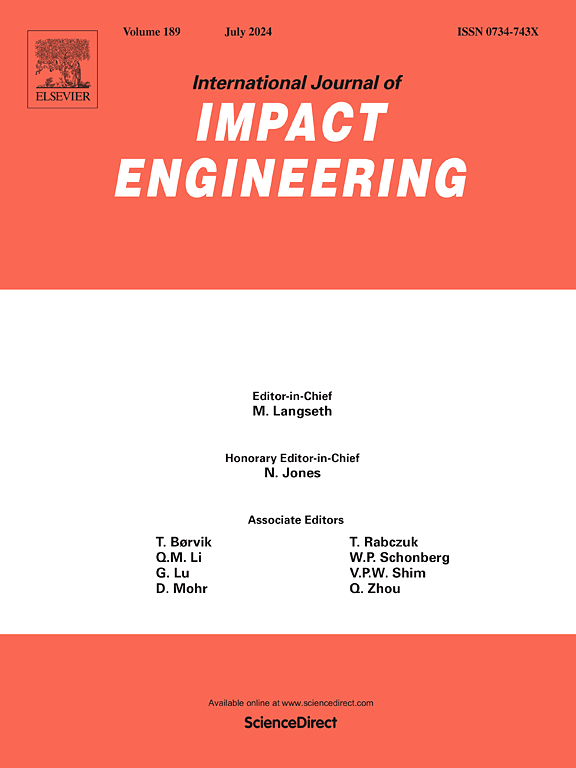Material constitutive modeling over a wide strain rate range by integration of cylinder and cap sample SHPB tests
IF 5.1
2区 工程技术
Q1 ENGINEERING, MECHANICAL
International Journal of Impact Engineering
Pub Date : 2025-05-02
DOI:10.1016/j.ijimpeng.2025.105368
引用次数: 0
Abstract
In this paper, the constitutive modelling method to cover a wide range of strain rate is studied by integrating the cylinder and cap sample SHPB (Split Hopkinson pressure bar) tests. In order to compensate the errors in the stain calculation for cap sample SHPB tests, a correct factor function of the temperature and strain rate is first established. Afterwards, a unification method is proposed to transform both the shear stress and tensile/compressive stresses in hot compression, quasi-static tension, cap and cylinder sample SHPB tests to VON MISES stress. In this way, all the data from different mechanical tests are used for data fitting the material constitutive models over a wide strain rate range. In the consideration of the coupling of thermal softening and strain rate hardening effects, both the classical and modified Johnson-Cook (J-C) constitutive models are developed for AISI9310 steel and ZL702A aluminum alloy. In addition, constitute modelling by means of Artificial Neural Network (ANN) models is explored. Two ANN (Artificial Neural Network) models with 6 and 11 neurons are trained for AISI9310 steel. According to the verification and evaluation with experiments by means of direct calculation and finite element method (FEM) simulation, the modified J-C model behaves best over the entire strain rate range, and the ANN model with 6 neurons wins over 11 neurons due to its success in avoiding the overfitting risk.
基于圆柱体和帽状试样SHPB试验的大应变率范围内材料本构建模
本文通过对筒盖试样SHPB (Split Hopkinson pressure bar)试验的整合,研究了覆盖大应变速率的本构建模方法。为了补偿帽样SHPB试验中染色计算的误差,首先建立了正确的温度和应变率因子函数。然后,提出了一种将热压缩、准静态拉伸、帽状和圆柱体试样SHPB试验中的剪切应力和拉/压应力转化为VON MISES应力的统一方法。这样,所有来自不同力学试验的数据都被用于在宽应变率范围内拟合材料本构模型的数据。考虑热软化和应变速率硬化效应的耦合作用,建立了AISI9310钢和ZL702A铝合金的经典和改进Johnson-Cook (J-C)本构模型。此外,还探讨了利用人工神经网络(ANN)模型进行结构建模的方法。针对AISI9310钢,分别训练了6个和11个神经元的人工神经网络模型。通过直接计算和有限元模拟的实验验证和评价,改进的J-C模型在整个应变速率范围内表现最好,6个神经元的ANN模型由于成功地避免了过拟合风险而优于11个神经元。
本文章由计算机程序翻译,如有差异,请以英文原文为准。
求助全文
约1分钟内获得全文
求助全文
来源期刊

International Journal of Impact Engineering
工程技术-工程:机械
CiteScore
8.70
自引率
13.70%
发文量
241
审稿时长
52 days
期刊介绍:
The International Journal of Impact Engineering, established in 1983 publishes original research findings related to the response of structures, components and materials subjected to impact, blast and high-rate loading. Areas relevant to the journal encompass the following general topics and those associated with them:
-Behaviour and failure of structures and materials under impact and blast loading
-Systems for protection and absorption of impact and blast loading
-Terminal ballistics
-Dynamic behaviour and failure of materials including plasticity and fracture
-Stress waves
-Structural crashworthiness
-High-rate mechanical and forming processes
-Impact, blast and high-rate loading/measurement techniques and their applications
 求助内容:
求助内容: 应助结果提醒方式:
应助结果提醒方式:


